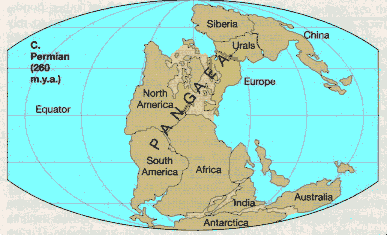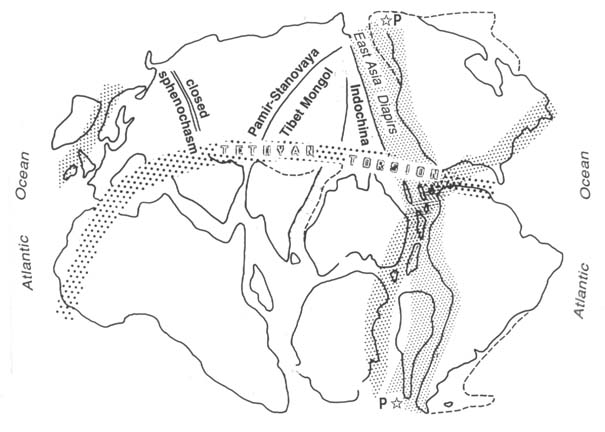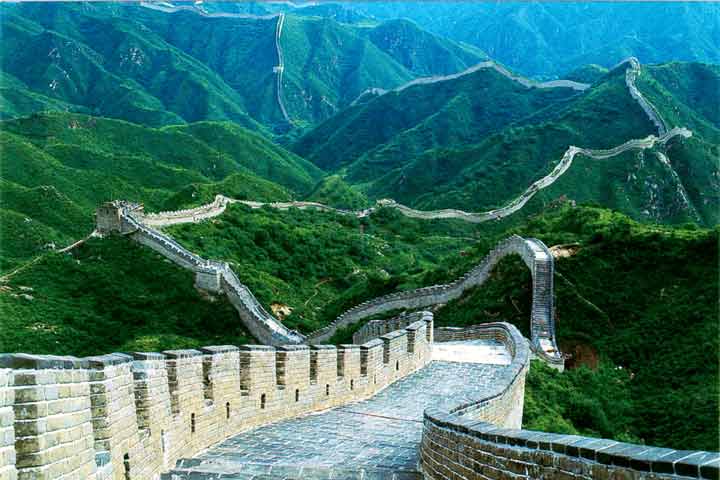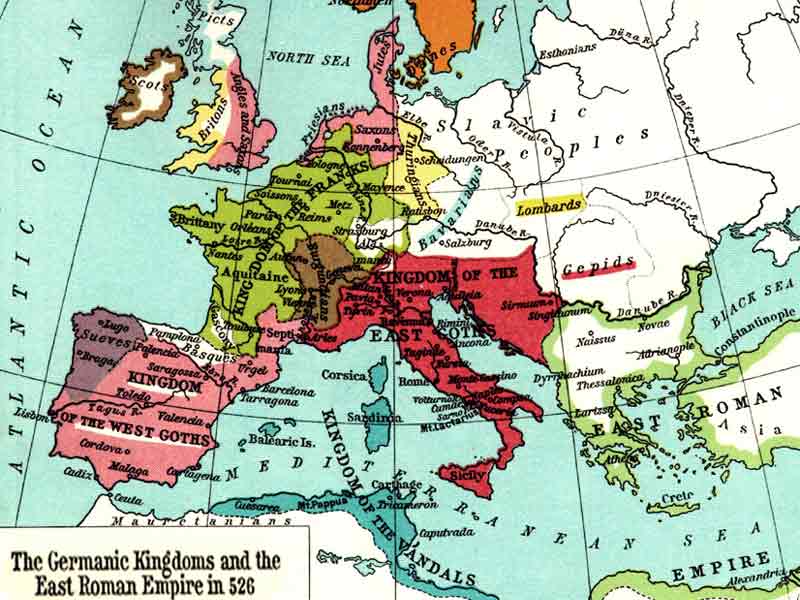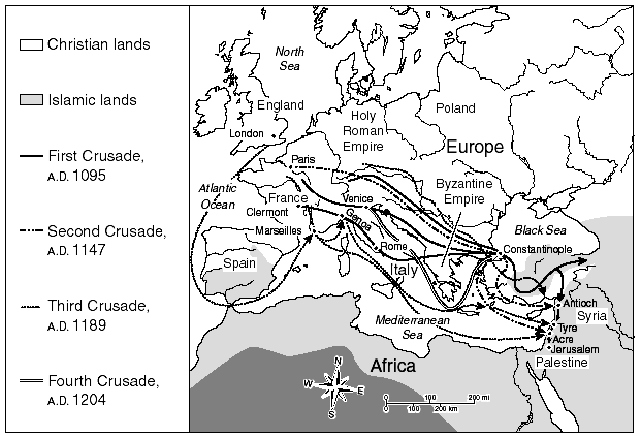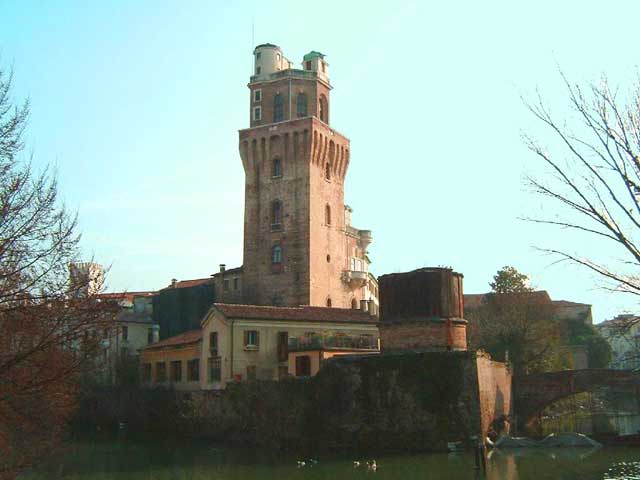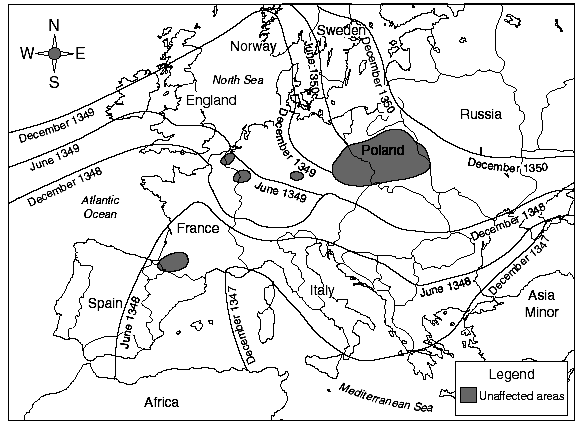Time Stops for None (but Eventually for All)
The Plot Thus Far...If history were taught in the form of stories, it would never be forgotten. - Rudyard Kipling 5 - 3 billion years ago - The sun was born, throwing off giant gas balls and spewing out elements that eventually coalesced into planets; earth, formerly a boiling ball of molten rock, began to cool and solidify; plates of solid land formed over the surface; water collected, forming oceans; the most basic forms of life (bacteria and blue-green algae) appeared in the electrochemical soup of the oceans. 600 - 200 million years ago - Fossils records appeared; the surface of the planet teemed with primitive life including a few still around today; non-aquatic plants appeared; extensive lava flows - perhaps accompanied by an asteroid impact - caused the Permian mass extinction wiping out 90% of all life on the planet although reptiles soon returned in force - then Pangaea formed when huge volcanoes exploded to the surface - only Eastern and Southeastern Asia and maybe Western North America (including Alaska and east Siberia) weren't included.
Lots about Pangaea remains conjectural - the first map is from Essentials of Geology p 432, the second from wholeo.net 67 - 65 million years ago - Mammals appeared; shortly thereafter (geologically speaking), a 6-mile-wide asteroid hit Chicxulub in the Yucatan with the force of 100 million megatons of TNT - the resulting heat pulse incinerated life on the planet in just a few hours; only those that were in burrows or underwater likely survived. 30 - 2 million years ago - Primitive monkeys and apes appeared in Africa; mammals began to acquire modern characteristics; dogs, modern-type horses, manlike apes appeared; the earliest hominid ancestors appeared, including "Lucy"; Ice Ages caused glaciers to advance and recede; ice carved the Great Lakes and created grasslands where humanoid evolution exploded; stone tool use began; primitive humanoids lived in communities, used fire, hunted, gathered; Homo erectus left Africa. 400,000 - 100,000 BC - Europeans lived in wood shelters and used weapons to kill big game; ocean-going vessels first used; clothes made from processed animal skins were developed and animals were domesticated. 69,000 - 35,000 BC - The last Ice Age; 1/3 of earth's surface was sheathed in ice for much of the period and world geography underwent a drastic change - revealing land bridges and creating ice bridges that assisted migration to all parts of the globe; fire was first used; medicines were developed; homo sapiens appeared. 12,000 - 4,000 BC - Glaciers restricted to Antartica and Greenland; giant mammals became extinct; someone painted graffiti all over a beautiful cave in France, the Christian god created the universe, modern human culture development and spread; settlements become cities; the wheel, pottery, and improved methods of cultivation occur in Mesopotamia and elsewhere; according to the Bible, a Great Flood killed almost everything and everybody on the planet. 4000 - 3,000 BC - Man started experimenting with metals; in the Middle East, the first cities were founded and the first constellations recorded; as the southern glaciers were done melting, worldwide sea-levels had risen over 300 feet; the Egyptians built the Sphinx and the Great Pyramid at Giza; Stonehenge was begun (taking 1,500 years or so to complete); Gilgamesh lived and wrote. 2,000 - 1,400 BC - The Egyptian alphabet was produced; the first code of laws was developed; Moses led the Israelites out of Egypt into Canaan in search of a homeland. 1,000 - 600 BC - The Old Testament was begun; the Iliad and Odyssey were composed; the first Olympic games were held and the first music written; money changed everything when people in the Middle East started using coins in trade; Lao-tse, Chinese philosopher and founder of Taoism was born; Alexander the Great lived. 600 to 200 BC - Confucius was born; the Parthenon was built; Plato lived and wrote his Republic; Pythagoras did math; shortly after, Buddha was born, Socrates was executed, Euclid and Aristotle lived and worked and the Mayan calendar was developed; the building of the Great Wall of China was begun.
The Badaling Section of the Great Wall Source: images.cnd.org 200 BC - 100 AD - The Roman Empire; astrology was invented; Spartacus led a failed slave revolt; Cleopatra lived and died; paper was developed in China; Julius Caesar, Augustus Caesar and Jesus of Nazareth were born; Jesus was executed; the Roman persecutions of Christians was begun; the Gospels were written; the Library of Alexandria rose to prominence - it contained lecture halls with 5,000 seats, was the first university and contained by far the largest collection of manuscripts to be seen for centuries thereafter. 100 - 350 AD - Hadrian ruled Rome; by this date, the Romans had paved 50,000 miles of road and begun a postal system; Christianity began to spread from a small cult to become the dominant religious and political power in civilised Europe; the Han dynasty ended in China; Mayan civilisation began its peak. A manuscript was recently unearthed during building work in Rome. Written in colloquial, even chatty, Latin (the translation can only be an approximation), the text is a 1st-century guide to etiquette during Saturnalia, the pagan festival which Christmas replaced.... 350 - 700 AD - The Mongols invaded Europe; the Roman Empire broke up; a plague spread through Europe; King Arthur lived; the silk industry developed; Mohammed founded Islam which grew quickly; the Chinese kept inventing stuff; in 585 AD the earliest recorded date of zero on copper plate occurred in India but it wasn't fully explained until the 7th century, making its way into Arabic books in 770, carried to Europe by the 8th century.
700 – 850 AD - The Arab empire extended from Lisbon to China; Charles Martel ("The Hammer"), savior of Europe, defeated the Arabs at Tours, halting the Arab advance; Caliph Harun al-Rashid ruled the "Golden Age" of Arab culture; pagodas spread to Japan from China; Vikings attacked Britain; Machu Picchu flourished in Peru; Charlemagne became the first Holy Roman Emperor. 875 AD - Russia was founded by Vikings.
1000 - 1100 AD - Vikings, Arabs and Jews mingled freely in the streets and marketplaces of Europe's major cities; musical notation was systematized; Turks forged high-quality steel; the Anasazi lived in the American southwest; Leif Ericksson discovered America; Beowulf was written; the Chinese invented gunpowder but used it only for fireworks; the Università di Bologna in Italy was founded under a charter from Frederick I Barbarossa making it the longest-lived university in the Western world (today, it is called the Alma Mater Studiorum); the first of many Crusades is launched in an attempt to defend the crumbling Byzantine Empire from encroaching Muslim armies - unlike most of the following Crusades, the First was a success and pushed the Muslim forces back, even recapturing the Christian city of Jerusalem.
The Specola, the former astronomical observatory of Bologna; Copernicus made his observations from there. 1100 - 1300 AD - The mostly Turkish Muslim armies regrouped and overan Edessa, then followed up by reconquering Jerusalem - this triggered a good half dozen Crusades, but none managed to duplicate the success of the First; the best was the Third (which fought Saladin to a draw), the worst was the Fourth, which got mixed up in the byzantine politics of the Byzantine Empire - its main accomplishment was sacking the capital of the very empire it was attempting to to defend; a dozen or more crusades followed against any number of targets but met with very little success in the Middle East and were increasingly disassociated from the church, whose temporal power was quickly fading; the leader of the only Crusade to even briefly recapture Jerusalem, the Emperor Frederick II, spent most of his life at war with the Papal States and was excommunicated twice (the Pope of the time was referred to him as the anti-Christ). But as organised religion's power was fading in Europe, it was growomg in Asia - the temple complex Angkor Wat was completed in Cambodia - then the largest city on the planet with over one million citizens; Genghis Khan conquered China, Persia, Russia - then died; the Magna Carta was signed in England; the Inquisition expelled Jews from Spain and Portugal and burned non-believers at the stake; Kublai Khan ruled the Mongols; Marco Polo went to China; the first Parliament was established in England. (Phew!)
European Kingdoms
Plus ça change plus c'est la même chose... The tournament is supposed to have been invented mid-11th century in France and developed as a popular form of regular training in the handling of weapons and horses. It rapidly became highly organised and hedged around with rules and elaborate pageantry. Ambitious knights travelled round Europe fighting in tournaments at fortnightly intervals. It is probable that such itinerant participants in tournaments helped to spread the usages and conventions of heraldry across Europe. Later in the Middle Ages the bearing of arms came to be accepted as an essential prerequisite of participation in a tournament. The growing importance of military pageantry and its association with the tournament would have excluded those of insufficient social standing who were unable to meet the expense, and this would have helped to restrict the use of arms to the knightly class. Thus, arms came to be seen as a mark of noble status, and were granted by the Holy Roman Emperor and the European kings as a corollary to ennoblement. In early days, however, most arms were self-assumed, and their owners sometimes changed them at will but even in the 12th century, and before the rapid proliferation of armorial devices led to a growing measure of royal control, there was some equation between nobility of blood and armorial bearings. This clue suggests an alternative theory for the origins of heraldry. Although heraldry came to have strong military associations, it may have developed from the civil personal mark, the seal device, of certain north European ruling families descended from Charlemagne, who perpetuated some of the administrative organisation and possibly the symbolic devices of his court. The latter included the sun and the moon, the symbols of the Evangelists: St Mark's lion and St John's eagle, and the fleur-de-lis (which later became the symbol of royalty in France). Consequently, the origin of heraldry was not Norman but Flemish. It is most likely, therefore, that the origins of English and Scottish armory are to be found not in Normandy (the Normans were of mixed Scandinavian and Frankish descent), but in the system adopted by certain ruling families descended from the Emperor Charlemagne, the military and political colossus who ruled the Frankish Empire of northern Europe from 768 to 814. These families perpetuated much of the administrative organisation of the Carolingian Empire, including the use of dynastic and territorial emblems on seals, coinage, customs stamps and flags. There is evidence to suggest that these devices were common to families or groups linked by blood or feudal tenure, and were of necessity hereditary. With the redistribution of lands following the Norman Conquest, the cadets in England of Flemish families who were of Carolingian descent, and the devices used by them, became integrated in Anglo-Norman society. During the first Crusade, only 30 years after the Conquest, the mass cavalry charge of mail-clad knights remained the standard tactic of warfare. Order was maintained in the ensuing fight by the use of mustering flags bearing the personal devices of commanders and it is clear that these were sufficiently distinctive to be recognised, even in the heat of battle. It is likely that they also possessed a peacetime function - that of marking territory and symbolising authority - and that the devices used for this purpose also came to be engraved on seals by which documents were authenticated. The proto-heraldic devices were displayed on seals and banners. Hereditary devices may have been known in 1066, and symbolic banners seem to have been carried at the battle of Hastings and in the First Crusade. Source: ceu.hu
1300 - 1400 AD - The Renaissance began; the Aztecs flourished in Mexico; gunpowder found its way to Europe and small cannon were soon developed; the Black Death spread across Europe killing 1/3 of the population; the Ming Dynasty began in China; an Italian invented the gun. The Terror of the Black Death
The Spread of Black Death The Black Death wiped out nearly one half of medieval Europeans. The first reports of the Black Death come from Sicily in October 1347. 12 Genoese galleys, which were said to have come from the Crimea, entered the harbour of Messina in Sicily. The crews were said to have "carried such a virulent disease in their bones that anyone who only spoke to them was seized by a mortal illness and in no way could evade death." A symptom of the black death was hæmorraghagic spots caused by blood seeping from damaged blood vessels beneath the skin - they were known as "God's Tokens". The average rate of spread of the medieval plague was between 1 and 5 miles (2 to 8 kilometres) a day, which suggests that it was mainly carried by infected people travelling on foot rather than on horseback. The plague probably arrived in Britain at Melcombe Regis (now called Weymouth), in Dorset, then an important town and port on the south coast - although Bristol and Southampton have also been suggested as the entry point. It may also have come from the Channel Islands, where it was already rampant and the fishermen were unable to pay their taxes because they were all stricken. Its arrival has been variously dated between June and early August 1348. The general direction of the spread of the Black Death in Britain can be determined from ecclesiastical records describing how the bishops in each diocese hastily had to appoint new clergy to replace those who had died. Historians disagree about the total number of people who died from the plague in London. Some have suggested a figure of 100,000 but a more reasonable estimate would probably be between 20,000 and 30,000 deaths out of a population of 60,000 to 70,000 - which would be in line with the death rates in other English cities. Because the devastation of the Black Death was outside their comprehension, people accepted unquestioningly the doctrine of the Pope and the Church that the visitation was God's punishment for their manifold sins. This unhelpful doctrine prevailed for the next 300 years and beyond. The Black Death moved from the most southerly point of Europe northwards to the freezing, inhospitable Arctic Circle, some 2200 miles (3500 kilometres) in less than three years. Plague victims suffered a sudden and high fever and developed large, foul-smelling boils; they were sometimes delirious and a severe headache was the usual prelude to death. The black death disappeared in 1670. It had been the scourge of Europe for 323 years. Note that it is distinct from Bubonic Plague - so named because of the swellings of the lymph glands (called buboes) which appear - which is still with us today. These two diseases are completely unrelated to each other. The average time from the point of infection to death was 37 days - of this the first 10 to 12 days was a latent period; the next 20 to 22 days was an infectious period before the appearance of symptoms. Therefore, 32 days was an incubation period. Physical symptoms would show for five days and then the sufferer would die. The total infectious period where the disease could be transmitted was 27 days (22 + 5). This long infectious period without showing symptoms accounted for its spread. Prior to 1670, the regions afflicted by hæmorrhagic and bubonic plague overlapped only on the Mediterranean coast. The former became established in Europe, with occasional forays into North Africa and the Eastern Mediterranean, while the latter had its stronghold in Asia and the north African coastlands, with rare outbreaks in Italy, Southern France and Barcelona that did not persist.
Marcello's Drawing of the Black Death in Italy 1348 AD
Here Is What the Black Death Might Be Like if It Reappeared Today...Sometime in the 21st century... The infection is brought back to the Western world by biologists who have been working closely with primates in the high forests of Central Africa. They return home to New York and unwittingly spread the infection widely when travelling daily on the crowded public transport. The subway, packed with constantly-changing passengers, allows transmission of the virus to a great many victims coming into the city over a wide radius. Some are visitors from all over the world. Trips to sporting venues, theatres and cinemas all disseminate the infection widely before the symptoms appear in any of the victims. When the primary cases die, the health authorities realise that their patients had contracted a serious, unknown disease; they take proper precautions with full protective clothing when nursing them and the bodies are sealed into special bags. Beyond that, there is nothing else that they can do. It is only when the multitude of secondary and tertiary cases began to appear all over the country and worldwide that the scale of the epidemic becomes apparent. Too late, the damage has been done. It proves impossible to establish any form of quarantine because the disease is spreading so rapidly. It is uncontrollable. This terrible bug particularly favours clubs, shopping malls, cinemas, sporting events, centrally heated offices and schools. These are all closed by law. The food supplies run out and looting and petty thieving are now rife. Gangs armed with knives and with whatever other weapons they can lay their hands on rove the streets seizing any food they can discover. The authorities, very sensibly, issue advice to the effect that it is dangerous for people to congregate at places of work - but then when the power workers refuse to report for duty, electricity supplies fail. Electricity, not petrol, is the life-blood of the developed economy and many people are now unable even to sterilise drinking water by boiling it. The complex fabric of life in the 21st century collapses completely. The rugged independence and self-sufficiency of their ancestors has long gone and they have been living a completely artificial existence based on computer technology, driven by international finance and a world economy. They had been cocooned by central heating, refrigerators, TV, rapid transport, convenience foods, microwaves, an array of electrical goods and the pharmaceutical industry. People were adept at surfing the Internet but had lost the basic instinct to survive. The global technology civilisation was precarious and any spanner in the works could have caused catastrophe - so this mysterious and horrific epidemic was an accident that was waiting to happen. The effects when the pandemic spread to India and China were truly catastrophic. It was unstoppable. Emergency health measures were limited and largely ineffective and supplies of painkillers and sedatives were rapidly exhausted. Terrified, everybody showed the usual response and fled by bus and train, carrying the disease far and wide. When authorities prohibited all forms of transport, people tried to flee on foot, dragging handcarts behind them. All to no avail - the epidemic spread steadily and remorselessly – an inexorable, gigantic evil wave of unimaginable terror and agonising suffering. The conditions were ideal for the bug and the teeming millions provided a seemingly endless supply of susceptible people. It was later estimated that the final death toll would be counted in billions. The Black Death had returned - 700 years after its first appearance. Its pattern of spread was broadly similar to that of the original pandemic, except that there was now an endless supply of victims all tightly packed together. Transmission was ridiculously simple and the economy of developed countries collapsed completely. Could the world recover from such a catastrophe? Source: firstscience.com based on the book Return of the Black Death: The World’s Greatest Serial Killer by Dr Susan Scott and Professor Christopher Duncan - they are at the School of Biological Sciences, University of Liverpool, England (e-mail: sscott@liverpool.ac.uk). The book can be purchased at Amazon.com. Also the science magazine Nature has another what-if scenario for a flu pandemic set in December 2005
Something Like That Might Even Happen...Bird Flu Virus Mutating, Posing Bigger Threat Says World Health OrgamisationHong Komg - The spate of human bird flu cases in Vietnam this year suggests the deadly virus may be mutating in ways that are making it more capable of being passed between humans, the World Health Organisation said. The finding points to the greatest fear of health experts that the H5N1 virus could unleash a pandemic and kill millions around the world if ever it gained the ability to be transmitted among humans efficiently. While investigators could not prove human-to-human transmission had occurred, the report said that "the pattern of disease appeared to have changed in a manner consistent with this possibility. They (the findings) demonstrate that the viruses are continuing to evolve and pose a continuing and potentially growing pandemic threat," the WHO said in a report. Klaus Stohr, WHO's global influenza programme coordinator, told a news briefing in Geneva: "We don't know whether the pandemic will occur next week or next year ... We should continue very intensively with pandemic preparations." H5N1 made its first known jump to humans in Hong Kong in 1997 and experts have always established that the mode of transmission was through direct contact with birds. But the virus has mutated since, raising fears among experts that it may one day adapt in humans and become easily passed between them, setting off a pandemic. In the 6-page report, produced after an expert meeting in Manila earlier this month, the WHO said at least 92 adults and children in Vietnam, Thailand and Cambodia had become ill after being infected with H5N1 since late 2003, and 52 of them had died. Stohr said the toll had risen to 97 cases with 53 deaths. In an update issued late on Thursday, the WHO said more clusters of infections involving household members have occurred, opening the possibility that "person-to-person transmission" may have taken place. Eight such clusters were observed in north Vietnam this year alone, with recent cases spanning over a longer period. "What we are seeing so far is a slight increase in clusters which could indicate more transmission," Stohr said. There was "circumstantial evidence" for such transmission - which could not be proved - but based on belief that a person became sick after being exposed only to an infected person and not to a sick chicken or duck, according to the expert. "Then you can talk about very strong evidence for human-to-human transmission. That has happened in three clusters, two in Vietnam and one in Thailand," he added. Regional Variations Recent cases raised the possibility that apart from being exposed to ill birds, the victims might have been infected through prolonged exposure to birds that did not appear sick but which were shedding the virus, or through contact with other sick people. The report also said that the age range of people infected in Vietnam this year had widened to between less than a year old to 80 years old. Equally worryingly, human H5N1 viruses isolated from Vietnam were genetically distinct from strains in 2004. Scientists also found that viruses from northern Vietnam and Thailand had begun to form a separate cluster from those isolated from south Vietnam and Cambodia. "It is possible that the avian H5N1 viruses are becoming more infectious for people, facilitating infection in a greater number or range of people and resulting in more clusters," it said. "It is possible that avian H5N1 viruses are becoming more capable of human-to-human transmission." Additional reporting by Stephanie Nebehay in Geneva Source: alertnet.org 19 May 2005 Reuters
1400 - 1600 AD - The first bank was founded; the Incas thrived in Peru; the Byzantine Empire finally collapsed and the Ottoman Empire was founded upon its ashes; Gutenberg created the printing press; during a never-ending quest to get more spices and silk, Columbus accidentally stumbled across the Americas - failing to notice that there were already millions of people living in the "new" world, Europeans moved in and slavery of native peoples and Africans began almost at once; one of Magellan's ships made it around the world; Shakespeare lived; Dutch painters flourished. But wait! There's more... (click "Next" below)
For more on modern history including both widely-known and little-known facts, opinions (mine and others), a few political cartoons, some photos, a map or two, rants, politicians,
geology, speculation and more, click the "Up" button below to take you to the Index for this History section. |
 Animals
Animals Animation
Animation Art of Playing Cards
Art of Playing Cards Drugs
Drugs Education
Education Environment
Environment Flying
Flying History
History Humour
Humour Immigration
Immigration Info/Tech
Info/Tech Intellectual/Entertaining
Intellectual/Entertaining Lifestyles
Lifestyles Men
Men Money/Politics/Law
Money/Politics/Law New Jersey
New Jersey Odds and Oddities
Odds and Oddities Older & Under
Older & Under Photography
Photography Prisons
Prisons Relationships
Relationships Science
Science Social/Cultural
Social/Cultural Terrorism
Terrorism Wellington
Wellington Working
Working Zero Return Investment
Zero Return Investment